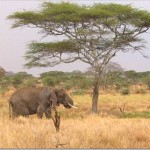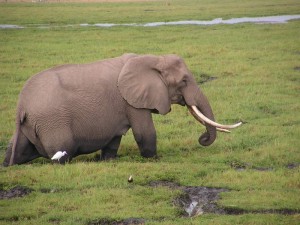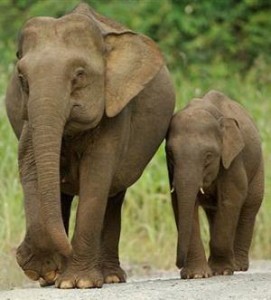Elephant Natural History
Written by Tina Dow for the Elephant Husbandry Resource Guide (2010)
 The elephant is the largest terrestrial mammal. Fossil records dating back to the end of the Pleistocene period, or 8,000 B.C., show that out of 182 species of recognized Proboscidians only two now remain. Currently there are two known genus listed under the Elephantidae family, Asian, Elephas maximus, and African, Loxodonta africana (Shoshani and Tassy, 1996). There are currently two recognized subspecies of African elephants; Loxodonta africana africana (Savanna elephant) and Loxodonta africana cyclotis (Forest elephant). Preliminary genetic evidence suggests that the forest elephant may not be a subspecies but in fact an actual second species of African elephant (Comstock et al., 2002). In the Statement on the Taxonomy of Extant Loxodonta published in February 2002, the IUCN/SSC African Elephant Specialist Group recommends that further genetic and morphological research be conducted before dividing African elephants into two separate species. Revisited in a statement in 2006, the African Elephant Specialist Group believes that more extensive research is still required. Additionally, the fear of having two recognized African elephant species may leave hybrids in an uncertain conservation status (IUCN Red List, 2009). Comparably, there is only one known species of Asian elephant with four known subspecies that are found primarily in Bangladesh, India, Sri Lanka, Indochina, areas of Nepal, Indonesia (more specifically Borneo), and Thailand; Elephas maximus maximus (Sri Lankan), Elephas maximus sumatranus (Sumatran), Elephas maximus indicus (Indian), and Elephas maximus boreensis (Borneo pygmy) (Shoshana and Eisenburg, 1982; Shoshani and Tassy, 2005).
The elephant is the largest terrestrial mammal. Fossil records dating back to the end of the Pleistocene period, or 8,000 B.C., show that out of 182 species of recognized Proboscidians only two now remain. Currently there are two known genus listed under the Elephantidae family, Asian, Elephas maximus, and African, Loxodonta africana (Shoshani and Tassy, 1996). There are currently two recognized subspecies of African elephants; Loxodonta africana africana (Savanna elephant) and Loxodonta africana cyclotis (Forest elephant). Preliminary genetic evidence suggests that the forest elephant may not be a subspecies but in fact an actual second species of African elephant (Comstock et al., 2002). In the Statement on the Taxonomy of Extant Loxodonta published in February 2002, the IUCN/SSC African Elephant Specialist Group recommends that further genetic and morphological research be conducted before dividing African elephants into two separate species. Revisited in a statement in 2006, the African Elephant Specialist Group believes that more extensive research is still required. Additionally, the fear of having two recognized African elephant species may leave hybrids in an uncertain conservation status (IUCN Red List, 2009). Comparably, there is only one known species of Asian elephant with four known subspecies that are found primarily in Bangladesh, India, Sri Lanka, Indochina, areas of Nepal, Indonesia (more specifically Borneo), and Thailand; Elephas maximus maximus (Sri Lankan), Elephas maximus sumatranus (Sumatran), Elephas maximus indicus (Indian), and Elephas maximus boreensis (Borneo pygmy) (Shoshana and Eisenburg, 1982; Shoshani and Tassy, 2005).
The Savanna elephant is the largest of all elephant species with males standing a shoulder height of between 3.2 m (10ft) to 4.3 m (13 ft) and weighing 4,000 kg (8,800 lbs) up to 12,000 kg (26,000 lbs). Female Savanna elephants, although quite large in their own right, are much smaller than the male with the average female standing 2.3-3.3 m (7-10 ft) at the shoulder and weigh between 2,700-3,600 kg (6,000-8,000 lbs). Unique to the African elephant is that both males and females can grow tusks. The Forest elephant, although similar to the Savanna elephant, is much smaller in stature. The average height and weight for the Forest elephant is 3.3 m (10 ft) and 3,200-4,500 (7,000-9,900 lbs) and 2.6 m (8 ft) and 2,300 kg (5,000 lbs) for males and females respectively. Although practically identical to the untrained eye, the Forest elephant is distinguishable from the Savanna elephant by their thinner, down-pointing tusks and smaller, more rounded ears (Grubb et al., 2000).
The Asian is slightly smaller than their African cousins; weighing on average of 3,000-5,000 kg (6,500-11,000 lbs) and as tall as 2.3-3.3 m (7-10 ft) tall at the top of the head. Easily distinguishable from the African, who has ears that are much larger and look very reminiscent of the outline of the continent of Africa, Asian elephant ears are much smaller and situated on a much more bulbous head. Within all subspecies of the Asian elephant, only the males are usually able to grow tusks. In the rare instance that the female Asian grows tusks they are always very short growing barely past the upper lip and are thus referred to as tushes. Additionally, the end of the trunk in the Asian elephant is different to that of the African elephant wherein it has only one tip, or finger, at the end, compared to the African elephant where there is both a tip, or finger, on the top and bottom. Moreover, the Asian elephant has five toenails on each of the front feet and four nails on each of the hind that grow outward instead of from the cuticle down, and only have 19 pairs of ribs instead of the 21 pairs in the African species. Regardless of elephant species, females are more commonly referred to as cows, males as bulls, and young ≤5 years of age are calves (Shoshani and Eisenburg, 1982; Sukumar, 1989; Fernando, et al., 2003).
Elephants live in a fission-fusion matriarchal society that is ever changing. The number of elephants within a herd can range from 4-50 individuals depending on death rates, birth rates, environmental conditions and available resources. It is because of these mitigating factors that elephant family groups are dynamic, consolidating into smaller groups when survival is put to the test, but reuniting into larger bond or clan groups when visiting communal watering holes or mud wallows (Douglas-Hamilton, 1972). Elephants usually restrict their daily movements to a home range of 10-20 km2; however during times of drought it is not uncommon for those distances to reach 90-180 km2 (Sukumar, 2003). Herds consist of adult females of varying reproductive status and their young ranging from newborns to postpubertal juveniles. Regardless of age, all herd members participate in the raising of an infant. The old African proverb,”it takes a village to raise a child”, definitely rings true for elephant. Elephants continue to learn well into adulthood, with rearing of young at the forefront of this process. Even as youngsters, elephants participate in breeding opportunities and births by watching and learning how to react and help a fellow herd mate (Lee, 1986; Lee, 1987).
Herds consist of adult females of varying reproductive status and their young ranging from newborns to postpubertal juveniles. Regardless of age, all herd members participate in the raising of an infant. The old African proverb,”it takes a village to raise a child”, definitely rings true for elephant. Elephants continue to learn well into adulthood, with rearing of young at the forefront of this process. Even as youngsters, elephants participate in breeding opportunities and births by watching and learning how to react and help a fellow herd mate (Lee, 1986; Lee, 1987).
Elephants in the wild have been observed to reach puberty between 8-15 years of age. At that time, males are slowly encouraged by adult cows to become more independent (Dublin, 1983). It is at this time that the young male is interested in investigating his own home range and slowly but surely leaves his herd behind. Young males have been seen to travel in bachelor herds with males of similar stature and age. Within these bachelor groups young males spare with one another and learn important skills that will one day become helpful when they reach a heightened state of sexual excitation called musth. Musth bulls must be capable of fighting other large musth bulls for the reproductive rights of estrus females, as well as defending those females once courtship and copulation has occurred.  Musth bulls have to be of peak physical condition to ensure that they survive the somewhat grueling month to three month long musth period that occurs annually (Poole and Moss, 1981; Poole, 1987).
Musth bulls have to be of peak physical condition to ensure that they survive the somewhat grueling month to three month long musth period that occurs annually (Poole and Moss, 1981; Poole, 1987).
No matter the distance between elephants, communication is always maintained. Elephants communicate over long distances via chemical and audible cues. Pheromones secreted in the temporal gland secretion and urine can travel great distances and alert individuals on the health of others, as well as stress and reproductive status (Rasmussen, 1998). Additionally, elephants are able to communicate infrasonically. Elephant rumbles, well below the range heard by the human ear, can travel up to several kilometers across savannah areas and shorter distances within dense forest cover. Communication among elephants become very useful when having to get a distress call out as a warning for others or locating lost herd members, as a way for individuals to “talk” to related and unrelated compatriots, or during times of reproduction a possible calling card to alert musth bulls that an estrus female is in the proximity and likewise (Payne et al., 1986; Poole et al., 1988).

